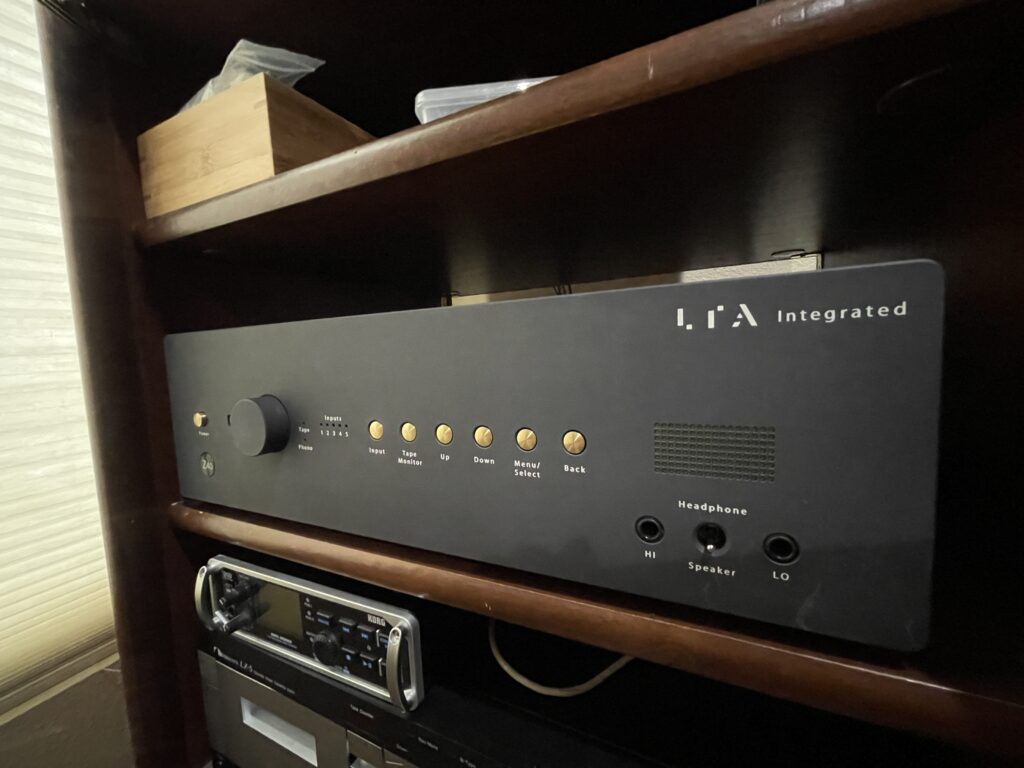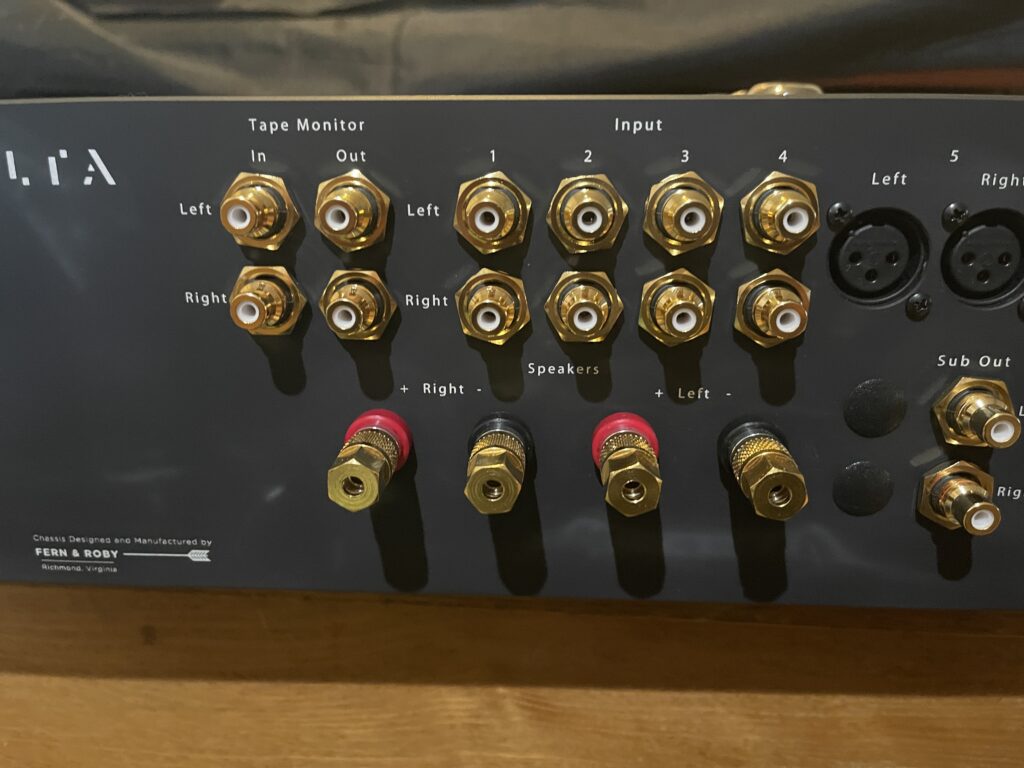Saying goodbye to my Marantz 2238b receiver
I lived for more than 40 years of living with my vintage Marantz 2238B receiver. It’s been a mainstay in my office space and served me for longer than I thought possible. Nearly 10 years ago, I did have the Marantz recapped. But in the years following, it just didn’t sound the way it used to. The tone had a bit of a raspy quality. At times, I would sense a subtle distortion.
When I tried to route an audio signal from my musical instruments, even if via a tape output from a mixer into the RCA aux input on the Marantz, more often than not, the sound was just not acceptable. There was clearly distortion. And no matter which mixer I used (and I have several options at my disposal), I couldn’t solve that issue.

Options to replace my vintage Marantz receiver
With my Marantz receiver, I had an RCA four-input switch box that I routed into the Marantz Aux input. Running a variety of items into that receiver, I wanted to find a replacement that would offer the type of inputs I need.
Inputs for my systems
I’m sure my situation is somewhat unique. Here are the sources in my listening space – inputs needed for all:
- Dual 1229 turntable
- Nakamichi LX-5 tape deck
- Oppo Ultra HD Blu-Ray Disc Player UPD-205
- Teac DAC UD-501
- Korg MR-1000 digital DSD recorder
- Macbook audio output
- Musical instruments via RME Babyface Pro audio interface (XLR outs)
So inputs of importance to me included:
- Phono stage
- Tape stage
- Four additional inputs with an XLR option on one of these
Tape stage is still relevant
Yes, there is a tape deck in my system. The Nakamichi cassette deck recently took over inputs recently occupied by my Akai reel-to-reel deck. With my collection of reel-to-reel tapes digitized, it’s time to move on to digitizing my cassette collection. That will keep me busy for a few months.
And while there is a tape deck in my list of sources, that isn’t why I wanted a tape stage. That input/output pair is needed for my Korg MR-1000. It’s been a cornerstone of my system for well over a decade. When I look to digitize analog sources be it vinyl or tape, these go into my trusty Korg.
Two options – Solid State or Tubes
Back in the 1970s, when radio was still king, receivers with the offering of a tuner, were extremely popular. Fast forward to today, radio is not what it once was. So, a tuner is no longer essential for me. And that opens up the world of integrated amps – something I had not previously explored.
With my input criteria as noted above, I narrowed my selections to one option from the world of solid-state integrated amps – the Yamaha AS2200. The price point on the Yamaha was reasonable enough and all of my input needs were checked.
But I continued to be curious about the world of tubes – that’s what years of reading Stereophile Magazine will influence for sure. But, scoping out integrated amplifiers with tubes, I sure had a hard time finding anything that provided all the inputs I wanted. That is until I stumbled upon the offerings from Linear Tube Audio.
Hello Linear Tube Audio
In my hunt for tube-driven integrated amps, it was Linear Tube Audio that came up in my search as the viable manufacturer for my system needs. I found at least three options that each provided all of the inputs I was seeking, including built-in phono stage and tape stage. If this would be the direction, the choice came down to watts – from a low of 10 to a high of 40.
My tube integrated amp decision
Reflecting on my last several visits to “The Show” in Los Angeles, a hi-fi showcase, I looked at my notes and remembered my impression of various tube systems I’ve heard over the years. Unfortunately, I wasn’t able to identify a location near me where I could audition a Linear Tube Audio (LTA) system in person, so it came down to making a decision based on assessing specs and reviews.
And the winner – the Linear Tube Audio Z40.

Impressions of the Linear Tube Audio Z40
And now I’m fast-forwarding about 9 months into my experience living with the Linear Tube Audio Z40. In a nutshell, I am beyond pleased.
The system delivered from a logistical standpoint. Everything I wanted to connect, is hooked up to the amp and behaves great. And the sound – it’s just – beautiful.

Typically, I don’t listen at very loud levels in my back-office space which is where I have this system set up. I have a sweet spot emerge when the integrated amp hits around 40 and above on its volume display. Once driven to at least this setting on the volume, the sound blossoms.
Among the surprises I’ve experienced, even something as basic as the spoken word, has been “head turning” at times. Sounding more natural than electronically reproduced. I’ve had this revelation hit me upon editing sessions of my podcast “The Places Where We Go” – something that never grabbed my attention with my previous Marantz receiver.
Music sounds wonderful through the Z40. The vast majority of my listening is classical, followed next by jazz, and a small smattering of rock and pop. My DSD recordings in particular come to life in a fantastic way when played through the Z40.
Tape stage anomaly
During one dubbing session, I noticed that if I reduce the master volume on the unit to zero, then nothing is sent to my recorder. So, it seems with the tape stage, the master volume on the Z40 needs to be at 1 or higher in order for the audio signal to pass through the tape stage output.
Not a deal breaker – it’s just that there are times when I just need to get something processing into my Korg MR-1000 and I don’t necessarily need to monitor the sound during the process. But now I know to at least keep the volume on the Z40 at a minimum of 1 and all is good.
Musical instruments sound stunning through the Z40
On my musical instrument setup which is routed into the Z40 via its XLR input from my audio interface, the sound is stunning. I run a program called Hauptwerk where I can play a variety of exquisitely sampled pipe organs from around the world on my organ console. The sound I get from this system with these organs easily exceeds the quality of the 3-console 80-stop Allen organ that sits at a church I sometimes play at a mile from my house. I love the low-end rumble when the bass pedals of the organ hit the low tones.
Remote control is a plus
When doing my initial research for this unit, I read several reviews that dissed the Apple Remote Control that ships with the Z40. I don’t remember the specific complaints that folks had about the remote. But, I have zero issues or complaints with the remote control. In fact, I use it daily – it’s super convenient and I really welcome that bonus item.
Conclusion
One happy customer here. All of my expectations have been met with the Linear Tube Audio Z40. Additionally, with a projected tube life of approximately 10,000 hours on this unit, it’s nice to know I won’t have to be swapping out tubes on a too frequent basis. It will be years before I need to think about new tubes.
The Linear Tube Audio Z40 gets a top recommendation from me.
My YouTube discussion on the Linear Tube Audio Z40
Disclaimer
Azure Hills Music contains affiliate links and is a member of the Amazon Services LLC Associates Program. If you make a purchase using one of these Amazon links, we may receive compensation at no extra cost to you. Read our disclaimer and privacy policy for more information.


